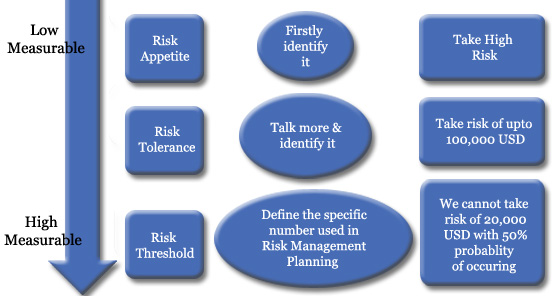

In the past few PMP® Certification Facilitation sessions, many professionals have been asking me –
Thus, I thought of explaining the same in my next blog post. Here, we will discuss each term in detail and study the differences. Now, the question is – What is the primary reason for the confusion among these terms? I observed the following crucial reason –
All these three terms reflect the attitude of an organization or stakeholder towards risk. The attitude towards risk showcases the varying degrees of risk stakeholders are willing to accept.
Let’s look at these terms one by one.
PMBOK® Guide Sixth Edition defines it as “The degree of uncertainty an organization or individual is willing to accept in anticipation of a reward.”
It is the high-level subjective description of the degree of risk. Which is acceptable to an organization or stakeholders. It’s an innate tendency like that of hunger and impacts our risk-taking behavior. It is not possible to measure hunger likewise, it is with Risk Appetite. But, when you interview stakeholders during Risk Identification Processor Risk Planning Process-
You observe their risk attitude. You see how they react to risk. Do they say, “We love taking risks, we were able to grow just because of our risk-taking attitude.” Such people rank amongst those who have high-Risk Appetite. Since they are willing to digest high risk. And, if you hear from stakeholders-
“We need to ensure that the project team takes on all commitments. We do not want to confront a situation where stakeholder interest is at risk; we want to play safe.” In this case, we mark the risk appetite to low.
”The degree, amount, or volume of risk that an organization or individual will withstand.”
Now, here you may notice that the very term ‘Risk Tolerance’ indicates –
The ability to measure since the definition included “amount or volume of risk that an organization or individual will withstand.” Here we are defining the risk attitude of stakeholders in the specific, measurable acceptance level of risk. For instance, I can take risks up to 100, 000 USD, or I can manage schedules variance of 10-20%. Likewise, during your interaction with stakeholders, you can figure out his risk appetite by asking how much is too much for you. And the answer which he gives you leads to defining Risk Tolerance.
PMBOK® Guide Sixth Edition defines it as “The level of risk exposure above which risks are addressed and below which risks may be accepted.”
You may notice that when we were talking about Risk Tolerance, we were speaking about the impact of risk in a measurable unit. But, here in the case of Risk Threshold, we also include the “level of uncertainty.” It means that we are further quantifying the Risk Attitude. E.g., “Will you be willing to take the risk of 100,000 USD with a 50% probability of occurring?”
During the Risk Management Plan, a threshold level is the one beyond which the organization does not want to tolerate the risk.
We apply this threshold to the risk exposure, and then Risk Exposure is calculated based on probability and impact. Now, it’s crucial to understand that when risk exposure is crossing the threshold –
The project management team has to take decisive actions (plan responses). These actions bring back the risk exposure under the threshold limits.
I hope, I have answered all your questions and doubts regarding the Difference Between Risk Appetite, Risk Tolerance, and Risk Threshold.
We did a live web clarification session on the Risk Management topic. You may want to watch it for the difference in Risk Appetite, Risk Tolerance and Risk Threshold
You can join the discussion on the same in our Forum. You can also log into our online program. Also watch the video on the same to understand regarding the Difference Between Risk Appetite, Risk Tolerance and Risk Threshold with examples.
Enroll to our FREE PMP® Certification Introductory Program to learn more about PMP® certification
| Name | Date | Place | – |
| PMP Certification and Training | 13 – 26 April 2025 | Bangalore | More Details |
| PMP Certification and Training | 10 May – 1 June 2025 | Chennai | More Details |